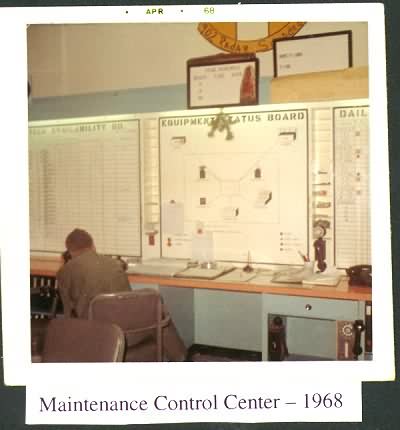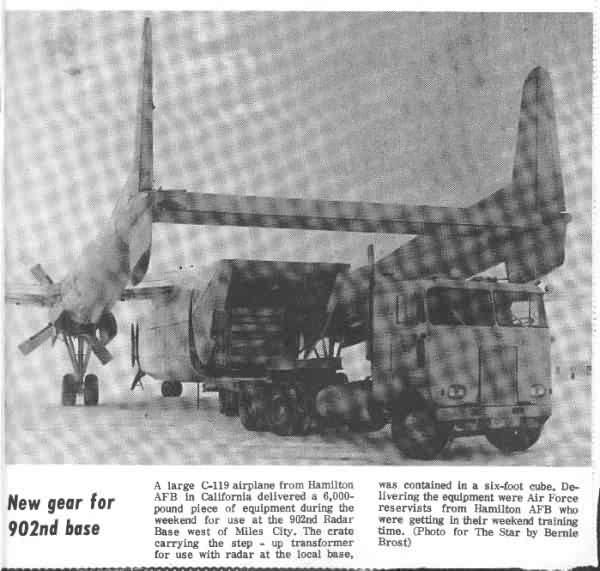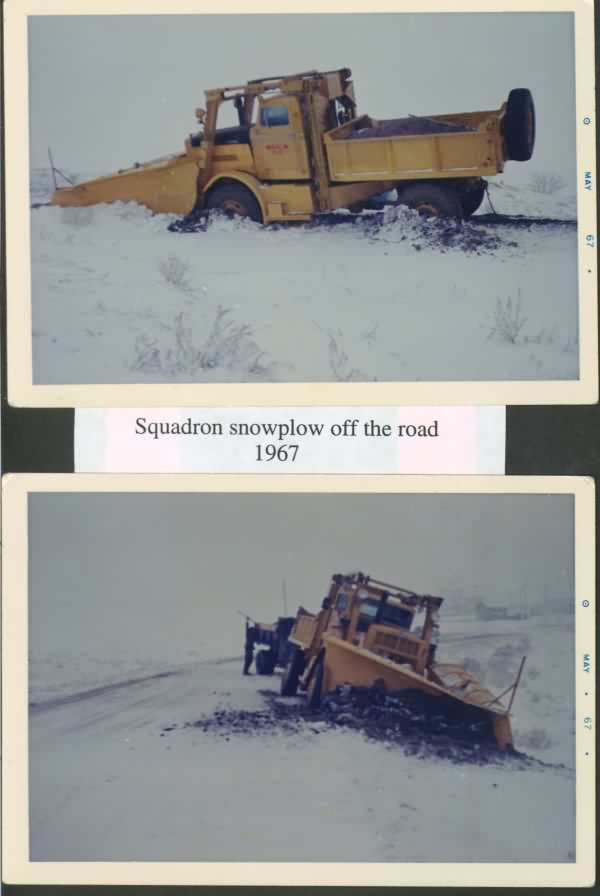
I arrived in Miles City, from Billings, by bus at about 8:30pm on the Thursday before the July 4th weekend in 1966. Louis Shaeffer, a classmate from technical school at Keesler AFB, picked me up at the bus station and drove me out to the site. When he and I had gotten our orders at the end of tech school, he told me that he had once lived in Red Lodge, MT and that Montana was full of mountains, streams and trees. I believed him, because I had never been there. It was dark when I arrived (Montana did not use Daylight Savings Time in those days), so I wasn`t able to see what the area looked like. However, the next morning I got up and went outside to have a look at the great scenery that he had told me about. I got a real shock when I discovered that from the site, there wasn`t a mountain to be seen, everything was a dull brown color and there wasn`t even a stick that resembled a tree anywhere to be had. Even though it wasn`t anything like the lush green rolling hills that I grew up with in central New York State, I soon found out that the Miles City area and Montana could be enjoyable. The nicest thing about Miles City, both the town and the military community, was the people. It was easy to make friends and there always seem to be a party going on somewhere. I became friendly with a local family who opened their home and included me in many of their family gatherings. I have stayed in contact with them since leaving Miles City.
I was one of about eight, or so, new 3 level radar technicians that arrived at the site that summer. The next several months were spent in classes, where we were taught about the Westinghouse AN/FPS-27 and General Electric AN/FPS-6/90 equipment that was used at the site. It was just like going through "Sets" instruction all over again. There was a former Westinghouse Tech Rep, named Frank Kuba, who guided us through the training period. The 7 level guys from the search and height finder shops assisted Frank and worked with us until we understood enough to take the 5 level tests. Every one of these people was "top shelf". They knew the equipment inside and out.
When we were qualified, we were assigned to the various crews. There were crews that worked only the day shift and then there were other crews, which were "lucky" enough to be assigned to the rotating shifts. Generally, the rotating crews worked a specific number of "Swings", "Mids" and "Days" followed by time off. The tough part of shift work was the "short change-over", which was when you might leave the shop at midnight and have to report for the dayshift the next morning. I also, remember the monthly "scheduled downtime" for the FPS-27. That was when the dayshift people got to do some night work. Downtime was usually a 12-hour period when the set would be off the air for "periodic maintenance".
When I was assigned to the unit we had specialty crews that concentrated their talents on different parts of the system. TSgt. Herb Craig headed up the "transmitter" group and TSgt. Bill Hatfield was the lead on the "receiver" gang. I ended up on Herb`s crew because I couldn`t align a receiver if my life depended on it. The Miles City FPS-27 was tweaked, during the maintenance periods, to a point where it out performed the other FPS-27 sets in the AF inventory. If anyone doubts that was true, I would tell you about the antenna wave-guide rotary couplers that kept failing or the "PEGE" flights when we never missed a target.
The rotary coupler incident was sort of funny in a way. A wave-guide rotary coupler allows the antenna to turn while the building full of equipment stands still. On the FPS-27 the rotary coupler was hung from the ceiling of the fourth floor receiver area, just below the antenna. There was always a high pitched hum coming from the coupler as the RF energy was being passed through. There were carbon-based seals inside the coupler, which if they failed allowed the RF to arc. The arcing was announced by a loud snapping noise. This type of failure was not a common occurrence. Our coupler had just such a failure. The problems started when the first 2 or 3 replacement parts also failed almost immediately. It wasn`t long before we had a tower full of QC guys and depot technicians, along with representatives from Westinghouse. We even installed a part that was operationally tested at Lewistown AFS, MT. You guessed it; our unit turned it into toast. Eventually, the transmitter RF output power was measured. BINGO, the problem was found. No FPS-27 had ever reached optimum output power, the Miles City unit was the first and we found the weak link in the chain. After that we had to run our primary transmitter at reduced high voltage, so that we stayed within the rotary coupler`s capability to handle the power.
Eventually, I transferred into the Maintenance Control Center (MCC). MCC was sort of a clearinghouse for maintenance activity and we handled most of the paperwork generated for scheduled and unscheduled maintenance. All job control numbers (JCN`s) were assigned through MCC and the files were kept there too. MCC, also, functioned as a communication link between the site and the direction center at Great Falls, MT. MCC personnel had to make sure that the power generating plant people were called in if stormy weather was eminent and the commercial power might be lost.

While working in MCC, I became involved in two very interesting happenings, that both were tied to the same problem. The FPS-27 experienced a pulse transformer failure that took one transmitter down. The pulse transformer was located behind the housing for the high power Klystron amplifier tube. Removing the transformer meant first removing the Klystron and all of its shielding. It was a big job, to say the least. The transformer, all 6000 pounds of it, was removed and sent on its way to the depot for rebuilding. The depot at Sacramento, CA was to send a replacement right away so that the site could be back to full readiness.
After a wait of several days plus, the replacement still had not arrived. The depot claimed that it had been sent and should have arrived within a few days. I got the task of trying to find out what had happen to the shipment. The transformer had been put in a railroad boxcar with some other material bound for the wilds of Montana. The Northern Pacific railroad brought the boxcar to the rail yard in Laurel, MT where the rest of the load was removed. Apparently, they didn`t notice this 6000-pound transformer setting there and they shoved the boxcar off onto a siding where it sat for several days. The right people were notified and the boxcar arrived in Miles City the next day.
The story should have end there, but it didn`t. The transformer was moved out to the site and unloaded at the rear entrance to the FPS-27 tower`s elevator. The crate was opened and QC inspected the transformer. During the inspection, it was noticed that several of the boltholes, along the flange that mated to the Klystron tube socket, didn`t go all the way through the flange. The paint was scraped away and auto body "bondo" was found filling the holes. Apparently, the flange had been damaged somewhere and the depot hacks tried to cover it up. Good bye RF seal. That transformer was sent back and an emergency request was made for another one.

That wasn`t the end of the story either. The depot decided to send the next replacement by air. That was a good idea, because it would arrive faster and not get side tracked. Well, I was working the MCC desk on the weekend when the transformer was winging its way to Montana. A call came in from Malmstrom AFB in Great Falls, MT. The National Guard plane was on the ground there and the crew wanted to off load the transformer and head back to sunny CA. They had determined that Malmstrom was the closest that they could get to Miles City. Malmstrom is several hundred miles from Miles City and I knew that ground transportation would be time consuming. I asked to speak to the aircrew and I asked the aircraft commander what service he would need if he were to fly into the local civilian airport. The plane would need high-octane aviation gas. I then made a call to the airport`s fixed base operator and made arrangements for the refueling. A local construction company was contacted to do the unloading and the deal was done. The next day was a Monday and we had a serviceable pulse transformer to install. Several other site personnel became involved and contributed to this successful mission, but I had the good fortune to have been right in the middle of it all, manning the phones and contacting the right people.
When the site closed in 1968, I was re-assigned to North Bend AFS, OR, where I continued to work in MCC. When the early releases became available in late 1968, I took the early out and drove cross-country back to central New York.
Here are some of the other things that I recall from my time at Miles City. They are in no particular order.
Being posted as a perimeter guard during an exercise with a WW2 carbine and a clip that had filament tape wound around it so that the ammo wouldn`t fall out and it couldn`t be put in the gun. The ammo clip always came with the instruction, "Here, put this in your pocket". I guess they didn`t want us to shoot each other.
Painting the top rail of the FPS-27 tower`s upper catwalk international orange, because it was the site commander`s favorite color.
This same site commander, Capt. Knickerbocker, had his camper (personal property) painted the same international orange under the cover of darkness (the middle of the night) by a couple of airmen. This happened the night before he left for his next assignment, following a really big going away party at the "Club".
Rattlesnakes in the buildings and on the walkways, and Black-widow spiders in the barracks.
Taking Coca-Cola from the vending machine in the FPS-27 tower elevator, and leaving IOU`s instead of cash.
A live performance by the Inkspots (a 50`s - 60`s Motown group) in the recreation hall.
A meal of Finger-steaks at the Airport Inn.
A local radio station with the call letters "KATL".
The night the power went off on the "hill" because somebody`s cat climbed a power-pole and shorted out a transformer.
The night some local, who was way beyond drunk, drove through the main gate, down the middle of the compound and off the helicopter-pad on the west end of the site.
Eight, or more site personnel racing their vehicles along the Interstate towards town to go bowling (this was somehow related to a requirement to do some sort of exercise or sport on a periodic basis) and passing Capt. Knickerbocker going the other way. Several guys owned really "hot" muscle cars. Chevelle SS396, Buick Gran Sport, Barracuda Formula S, Mercury Cyclone, Ford Galaxie 7 Liter, plus assorted hopped-up machines.
The NCO`s wives giving the single guys pointers on what laundry detergent to use with the strange "soda-water" that came from the site wells, so that they could get their clothes clean.
The group of buildings on the west end of Miles City where "Ladies of the Evening" provided comfort for those that needed it.
There was a nightclub out of town to the east that had a huge dance floor. I think that it had featured top named national bands in its heyday. You had to turn off the highway and go under the Milwaukee Railroad tracks to get to it. It was somewhat rundown in the 60`s and I believe it burned down some years later.

Having a formal "Dining-In" to celebrate the selection of one of our own as "Airman of the Year" for the Aerospace Defense Command. I don`t remember his name, but I recall that he was a SMSgt., who was also an ordained Baptist minister. He was instrumental in organizing a local Baptist congregation.
Falling asleep on "Mids" with the elevator at the top with the doors open. When the day shift came in and pushed the elevator call button a bell rang. How thoughtful the AF was to have an alarm clock built into the tower.
Pushing the alarm test button in the FST-2 area. That worked just like the elevator call bell.
Wondering what went on behind the locked doors of the "Comm Center".
Wondering what the chances were that the "enemy" was going to penetrate all the way to eastern Montana and put us on the front line.
Taking the site`s bus to make the monthly trip to Glascow AFB, so the wives could shop at the Commissary and BX. I made the trip once to take my records to personnel. We had to drive a herd of sheep off of the road so that the bus could pass. It was an all day trip. The highlight of the trip was crossing the Fort Peck dam.
A popular local pastime on Friday and Saturday nights was "Dragging Main". Carloads of people would drive back and forth from one end of Main St. to the other.
Driving 150 miles to Billings to go shopping or for a night on the town.
Gumbo, the dirt variety!
Representing the USAF by marching in the annual "Bucking Horse Sale" parade and then losing the "Best Unit" award to a group of 8 to 10 year old baton twirlers.
We had a FPS-90 magnetron operate in excess of 97,000 hours. It received a plaque and was on display in the height finder shop.
Went to a "Kegger" party out in the Pine Hills. Got drunk, but remember making out with somebody`s wife.
Many of the locals drove pick-up trucks with stock racks mounted on the bed; they usually had a rifle hanging in the rear window and a saddle hanging from the stock rack.
There was a "Drive-in" restaurant on the eastside of town that featured "cherry cokes".
The "F Troop" Commander`s and 1st Sgt.`s hats hanging on the wall behind the bar in the Club.
Helping the Bureau of Land Management fight a range fire.
Water for the chow hall being hauled from town in garbage cans.
I got a speeding ticket one night on the Interstate headed into town. I was clocked doing 70 MPH in second gear with a 1952 Hudson Hornet. I was driving, but it wasn`t my car. The owner wanted to take a ride in the backseat. When we hit the highway he says, "Kick it in the ass and see what it`ll do. I found out soon enough. The Highway Patrolman that wrote the ticket also took the picture of our replacement transformer for the local newspaper.
On New Years Eve 1967, there was a big party at the Club. The guy that owned the Hudson was restricted to the barracks for some reason, so a couple of us smuggled his girlfriend into the barracks so that they could spend some time together.
That wasn`t the first time women had been in the barracks. I returned to my room, from the showers, one night and found that my roommate had brought two females in to listen to some new records he had bought. There I was in "flip - flops" with a bar of soap in my hand and my towel over my shoulder.
I remember a civilian who worked in the chow hall. He liked to drink (a lot) and I think he lived in his car, but he could play the vibes like nobody`s business. Sometimes he would set up in the club and play for drinks.
The last site commander always went directly to the club, immediately after retreat, for a few boilermakers.
Most people should remember "Beer Call" on Fridays. Everybody working the dayshift could leave an hour early, but you had to join the party at the club. A Sgt. Garcia would have the barbecue going just outside of the door.
I earned extra cash by "moonlighting". I helped move 50 tons of "feedblocks" from a railroad boxcar in Miles City to a ranch way out on the Powder River. A group of us worked building fences on a ranch south of Miles City on the Tongue River. The ranch belonged to the president of one of the banks in town. The ranch covered an area of 100 sections with a section being 640 acres, 64,000 acres. A friend of Frank Kuba`s held the contract to build the fences and Frank recruited several airmen to do the labor.
I returned to Miles City once, back in 1983. I had just gotten married and my wife and I were on our honeymoon. I went out to the site area and looked around and took a couple of pictures. There`s not much left. If you are ever in Miles City, check-in at USDA Range Station on the west end of town. They can arrange for you to get through the locked gate that is at the entrance off the highway. If you go in while the gate is unlocked, be sure to take the padlock in with you, so that you don`t get locked inside.